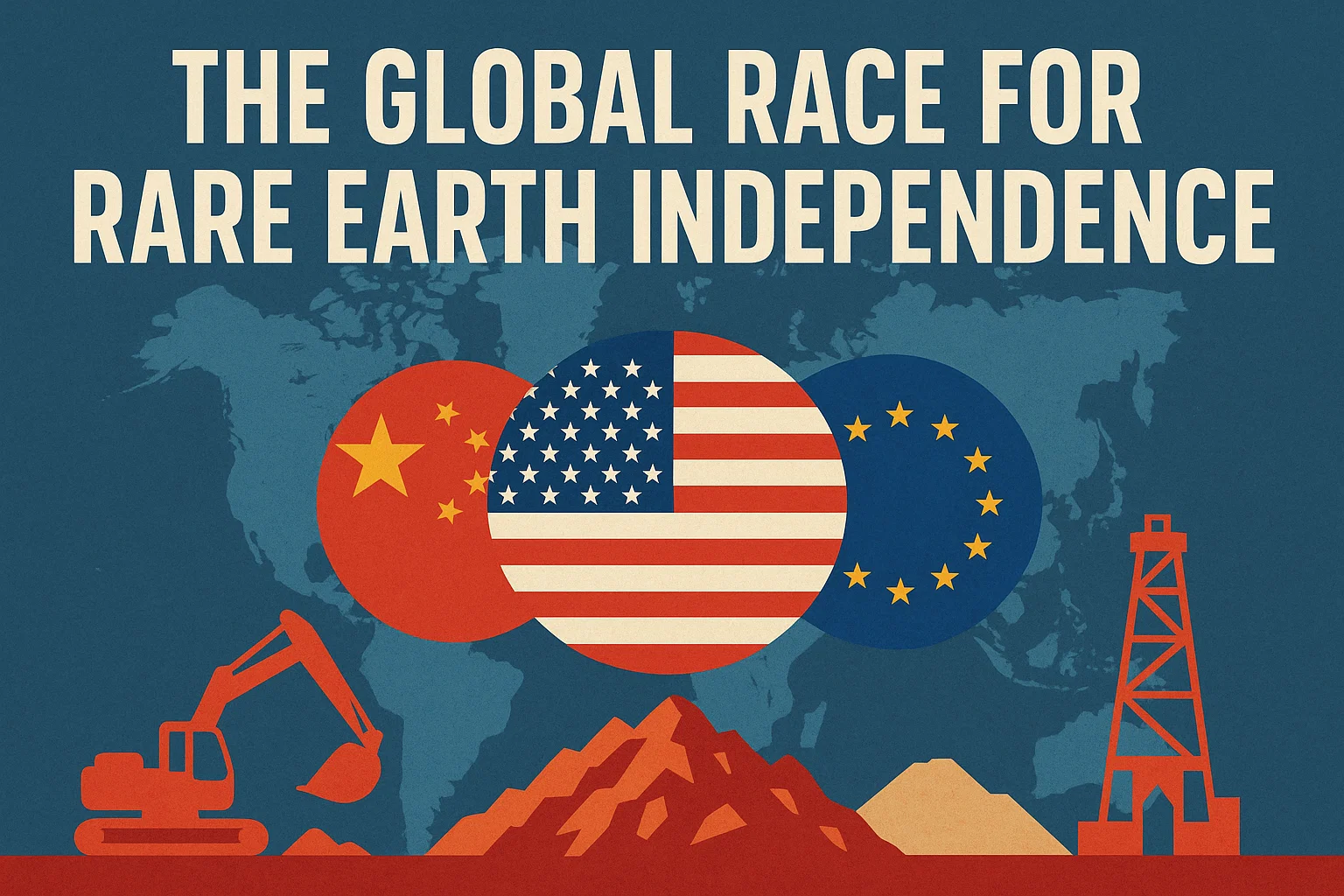The Global Race for Rare Earth Independence
Explore how rare earth elements power global technology — from EVs to defence systems — and why nations are racing to reduce dependence on China. Learn how India’s mineral reserves, policy reforms, and international partnerships can turn it into a leader in the global rare earth ecosystem.
The Global Race for Rare Earth Independence – India’s Strategic Opportunity in Critical Minerals
The modern world runs on technology. From smartphones and laptops to electric vehicles and fighter jets, almost every advanced device depends on a small but powerful group of materials known as rare earth elements. These elements are vital to building the magnets, batteries, and electronics that power our everyday lives. Yet, behind this technological progress lies a critical vulnerability: the global supply of rare earth elements is overwhelmingly controlled by one country. This heavy concentration of production and refining capacity poses serious risks for other nations, threatening their economies, industries, and even national security.
Essential Tech Metals
Rare earth elements, often called REEs, are a group of 17 metallic elements found in the Earth’s crust. They include materials with unusual names such as neodymium, dysprosium, yttrium, and europium. Though not truly “rare” in terms of availability, they are scattered in very low concentrations, making them difficult and costly to extract and refine.
These elements are the foundation of modern technology. For example:
- Neodymium and praseodymium are used in strong permanent magnets found in electric motors and wind turbines.
- Europium and terbium give colour to TV and phone screens.
- Gadolinium is used in MRI machines for medical imaging.
- Dysprosium strengthens magnets so they can withstand high temperatures — essential for electric vehicles and aircraft.
They also play an indispensable role in national defence, being used in radar systems, precision-guided missiles, and jet engines. Without these materials, many of today’s advanced technologies simply could not exist.

Misleading Name Explained
Narayan Ramachandran, in his analysis of rare earth geopolitics in “Loosen China’s Grip on Rare Earths: India Can and Must” (Mint, Nov 4, 2025), points out that the term “rare earth” is actually misleading. It comes from an old industrial term used when these elements were first discovered in the 18th century. They are not particularly rare in the Earth’s crust — in fact, some are more common than gold. What makes them “rare” is the difficulty of extracting and purifying them economically and safely. The mining process involves separating chemically similar elements, which requires complex refining techniques that can produce large amounts of toxic waste. This explains why only a few countries dominate global production — not because others lack the minerals, but because refining them safely and profitably is difficult.
China’s Rare Earth Dominance
For several decades, China has held a commanding position in the rare earth industry. Today, it controls about 90 per cent of the world’s refining capacity and supplies the majority of processed rare earths used in manufacturing worldwide. This dominance is the result of deliberate long-term planning and investment. During the 1980s and 1990s, while other countries hesitated due to low prices and environmental concerns, China built massive refining facilities and gained unmatched technical expertise.
This has given China a powerful economic and geopolitical advantage. Ramachandran notes that China has not hesitated to use this dominance strategically — for example, by restricting exports and raising prices during trade disputes with the United States. Such actions demonstrated that China views its control over rare earths as a “credible card” in global politics. The result has been widespread disruption in global markets, exposing how dependent modern economies are on a single supply source.
This overdependence on China has made many countries uneasy. It has become clear that technological progress and national security are both at risk when critical materials can be used as political leverage.
Costly, Complex Production
Producing rare earth elements is a long, costly, and environmentally demanding process. Mining companies must extract ores that contain only small amounts of rare earths, then separate them through a series of chemical processes. This generates radioactive waste and toxic by-products, which must be handled carefully to avoid environmental damage. Countries with strict environmental laws often find it uneconomical to compete with China’s lower-cost and less regulated production.
Moreover, developing a full rare earth supply chain requires enormous investment, advanced chemical expertise, and years of experience. Once China established itself as the leader, other nations found it difficult to catch up. However, this dominance is not permanent. Rising prices, geopolitical tensions, and global supply chain disruptions have changed the situation, prompting renewed efforts worldwide to diversify production and reduce dependence on China.
The Global Response
Countries worldwide are addressing the rare earth crisis through two main strategies: diversifying supply chains and developing innovative substitutes.
To reduce dependence on China, nations such as Australia, the United States, Japan, and the European Union are reviving and expanding their rare earth industries. The United States has reopened the Mountain Pass mine in California with government support, while Australia’s Mount Weld mine now stands among the most productive outside China. Meanwhile, the European Union’s “Critical Raw Materials Act” encourages investment and secures future supplies. Governments are increasingly willing to accept higher environmental and financial costs for the sake of long-term security. Once content with China’s cheap exports, they now recognise that resilience and strategic independence outweigh short-term economic convenience.
At the same time, many countries are pursuing technological innovation to reduce reliance on rare earths altogether. Scientists are experimenting with alternatives such as iron nitride and ferrite magnets made from abundant materials, while engineers are redesigning electric motors and turbines to use smaller quantities of rare earths or rely on advanced software to boost efficiency. Ramachandran also notes India’s progress with samarium-cobalt magnets, which are highly heat-resistant and require fewer rare earth imports. These advancements show how India and other countries can shift from being mere suppliers of raw materials to leaders in developing technological solutions for global supply chain security.
India’s Opportunity
India is uniquely positioned to play a central role in the emerging rare earth economy. It has vast mineral reserves — among the largest in the world — yet its production and refining capacity remain minimal. This contrast between potential and performance reflects what Ramachandran calls policy inertia — a long-standing lack of urgency and reform in India’s approach to critical minerals.
A major issue is the fragmented nature of India’s governance in this sector. Responsibility for rare earths lies across several ministries, particularly the Department of Atomic Energy, which has traditionally prioritised nuclear research over industrial development. Ramachandran suggests establishing a new Department of Critical Minerals focused solely on developing and managing these resources. Such an institution could streamline policies, attract investment, and coordinate with international partners more effectively.
Developing a strong rare earth industry requires enormous capital, advanced technology, and global collaboration — beyond what public sector enterprises can provide. India’s government must therefore encourage private sector participation. Allowing private companies to explore, mine, and process rare earths under transparent regulations would attract innovation and efficiency. Similar liberalisation in sectors like telecommunications and renewable energy has already proven successful in India.
International cooperation will also be essential. Through frameworks like the Quad alliance (India, Japan, the United States, and Australia), India can combine its natural resources with its partners’ technological expertise and investment capacity. Joint ventures and technology transfers could help India move up the value chain — from mining raw materials to manufacturing high-tech components such as magnets and sensors. These partnerships also align with India’s broader “Atmanirbhar Bharat” (self-reliant India) and “Act East” policies, which aim to strengthen both independence and regional collaboration.
Environmental and Technological Hurdles
While India’s potential is great, the challenges are equally significant. Rare earth extraction is environmentally sensitive, involving hazardous chemicals and large-scale waste management. India’s dense population and strict environmental laws mean that mining projects often face public resistance and regulatory delays. Balancing industrial growth with environmental protection will require innovation in cleaner, more sustainable extraction methods.
In addition, India must strengthen its technological capabilities. It is not enough to export raw materials; the country must invest in research and development (R&D) to build advanced materials, magnets, and components. This would ensure that India captures more value from its resources rather than relying on imports of finished products.
Strategic and Military Importance
Beyond economics, rare earths have enormous strategic and defence implications. They are crucial for radar systems, jet engines, guided missiles, and other high-tech military equipment. As geopolitical tensions rise, ensuring a secure and independent supply of these materials becomes a matter of national security. Integrating rare earth policy into India’s broader defence strategy would not only strengthen its security but also reinforce its position as a key regional power in the Indo-Pacific.
Conclusion
Ramachandran’s analysis captures the global rare earth challenge as both a warning and an opportunity. The warning is unmistakable: dependence on one nation for critical resources threatens both economic stability and national security. Yet, within this risk lies a unique chance to build a fairer, more resilient global system. For India, this is a defining moment to act decisively. By reforming outdated institutions, encouraging private investment, protecting the environment, and advancing scientific research, India can transform its vast mineral reserves into strategic strength. Effective cooperation with global partners will further help it rise from a passive supplier to a pivotal force in the rare earth ecosystem. Success would not only boost India’s economy but also strengthen global supply stability and reduce overreliance on China. As Ramachandran concludes, hesitation is no longer an option — the race for rare earth independence has begun, and India must lead from the front.
Subscribe to our Youtube Channel for more Valuable Content – TheStudyias
Download the App to Subscribe to our Courses – Thestudyias
The Source’s Authority and Ownership of the Article is Claimed By THE STUDY IAS BY MANIKANT SINGH





